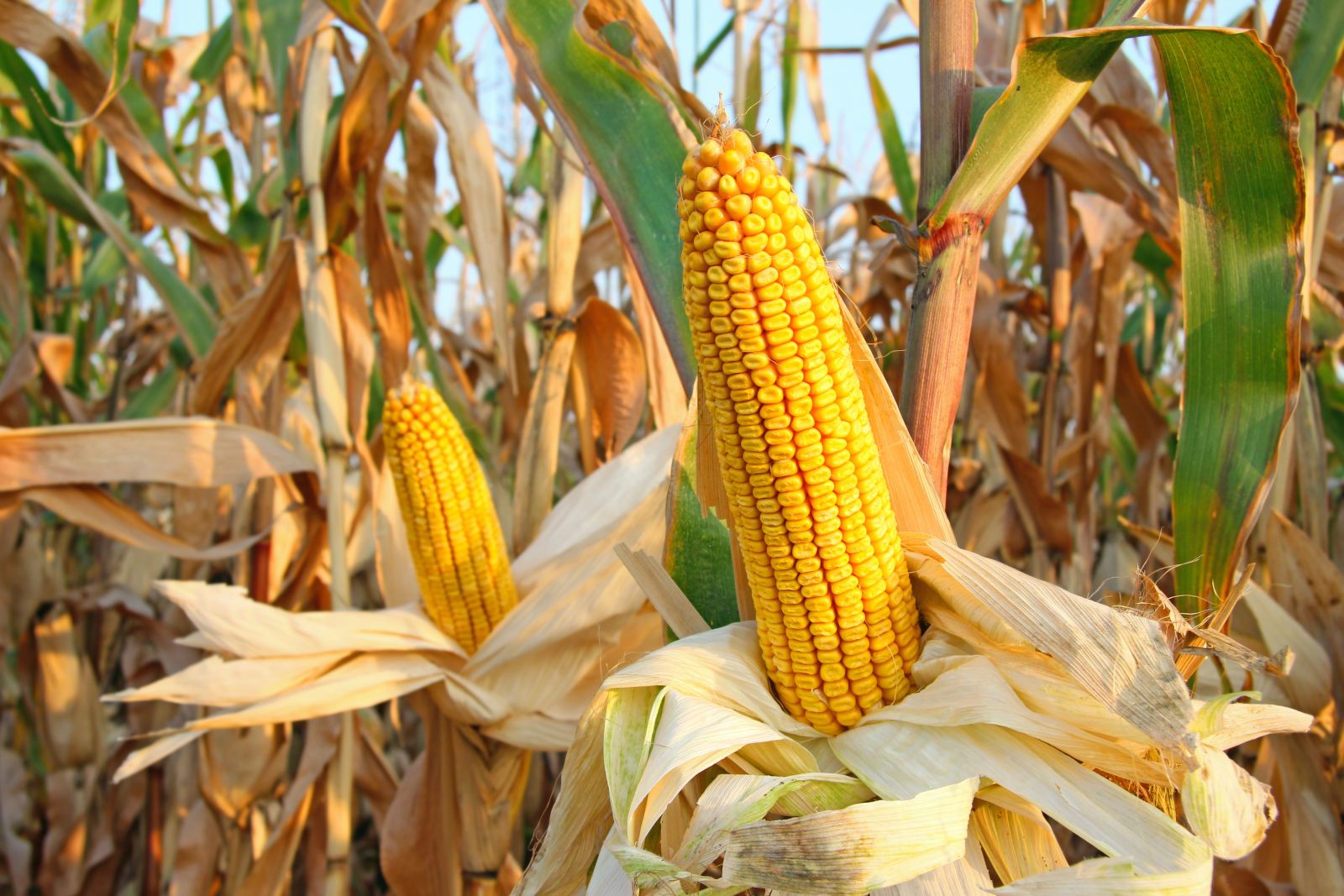
Earlier today I joined Michelle Rook, on AgWeb's Markets Now, to discuss the corn, wheat, and soybean markets. She also asked me about the cattle market, the stock market, and interest rates.

Michelle: Welcome to Markets Now, I'm Michelle Rook with Darin Newsom, Senior Market Analyst with Barchart. Grain saw some early pressure. Corn has been trying to come back, but effectively we've been mostly lower here this morning while the livestock futures are seeing some back-and-forth trade both in the cattle and the hogs, and right now cattle futures are mostly higher.
All right, Darin, let's talk a little bit about the grain trade first. Kind of disappointing that we're not seeing or haven't seen a whole lot of follow-through buying activity after a pretty good corrective day yesterday, especially in the corn, but corn's been trying to come back here. We did see a new contract low yesterday and then moved to the plus side. If we close higher today, do you think that will confirm a reversal and will we get more buying as a result?
Darin: The short answer to all of that is yes, I do think we're going to see some follow-through buying start to develop in the corn market. Why is-- my initial response, my initial thought at Tuesday's close was the rally was tied to some non-commercial shortcoming. Therefore, we should have seen total open interest in the corn market drop similar to what we saw in Chicago wheat.
What we actually saw according to the CME website was that total open interest in corn increased by 17,000 contracts. That tells me, as we were pushing lower and initially tried to go down on Tuesday and then it rallied, there was some new buying coming in. What was interesting about Wednesday morning is we saw a similar pattern where corn tried to go lower early and just couldn't push through the previous low, 450 or so on or wherever that was, and it held and has since rallied again. Now we'll see if it can hold through the close.
Again, it's a Wednesday. There's just not much going on. Tuesday was the last day of the positioning week for funds and non-commercial traders, so that often leaves Wednesday just to kind of bounce around. We'll see if it can build any momentum heading into the close.
Michelle: Yes. If you look at one of the reasons that we might not be up today in the corn or be able to hold things together is the fact that the wheat market was up yesterday and that helped to pull the corn along. In the case of the wheat market, is that basically all been short-covering when we see those pops too?
Darin: Yes, it is. Again, what played out as expected, I think total open interest dropped something like 3,600 contracts in Chicago. March was down 5,000, 6,000 contracts, or something like that. I'm not one of those convinced that it was Chicago wheat that pulled corn higher. I think we've basically had the same setup in both where spreads are basically neutral, maybe leaning a little bit bearish.
Basis is running bearish. You've got non-commercial traders holding a large net short in both markets ahead of USDA's data dump on Friday. Not so surprising that Chicago wheat's able to bounce occasionally on some short covering. It just doesn't have any staying power. There's no fundamental reason right now for it to continue to move higher.
Michelle: Yes, because the demand actually has not been very good, very anemic, hasn't it?
Darin: It has. If we look at wheat as a whole, it hasn't been great. Now it is better. If we look at exports, it's better than last year, but last year was basically non-existent. I know when I say that, we can break soft red winter out on its own. It's up. Total sales right now is up 82% from last year just in soft red winter wheat, but again, we have to put an asterisk by that. It was nothing last year. The 2023 marketing year, we didn't do anything in soft red winter wheat, so the fact that we're up 82% from almost nothing doesn't really instill me with a great deal of bullishness about Chicago wheat.
Michelle: No doubt. As we speak, we're starting to see wheat push just fractionally higher, but as you point out, may not have a lot of reason to stay there. Soybean market, some pressure again here today, but a little pop yesterday. We've taken a lot out of this market since we got some of those rains in Brazil, haven't we?
Darin: Yes. The thing that stands out to me in the soybean market is what's going on in the spreads. We've seen the carry in the March-May continue to strengthen, and in fact, taking it beyond the 33% threshold to calculate full commercial carry back into neutral territory, so we'll see where we close here on Wednesday. Also, if we go further out into the May-July, and this is where we can really see not only the effects of Brazilian production on the commercial side of the market but what it might mean for demand for US supplies, and we're seeing that carry strengthen as well.
In fact, early this morning, that May-July spread was testing its previous low daily close of $8.25 carry. Now, it's still bullish, so we still know that we're dealing with some tighter supplies, but if we push through that, it doesn't take much imagination to see it going to the same level where the March-May is, $10.25, $10.05, maybe even larger carry, meaning that the commercial side just really isn't overly concerned. Again, mostly to the fact there's just not a great deal of demand right now for US supplies.
Michelle: Let's talk about that because usually when we get a big pullback in price, you will start seeing some flash sales that'll go out, some of the end users finding value there. Is the reason that we are not seeing that because of some of these shipping issues, or is it just there's other places to go in the world?
Darin: Number one, there's other places to go in the world. We know the world's largest buyers are not going to buy from the US unless it absolutely has to. If it was just simply a shipping issue, I think we would still see sales being made, and our total sales would be accumulating. We're running 16% behind last year's total sales for the same week at the end of December. We're really just not making sales at all.
As far as shipment goes, we're running something like 22%, 23% behind last year's pace. Some of this is due again, yes, we're having some shipping issues, but by and large, nobody wants it, and they're not going to buy it. It doesn't really matter what USDA makes up in its next guess for Brazilian production. Bottom line is it's a demand issue right now, and we're really struggling with that here in the US.
Michelle: We've made some new lows for the move in the soybean market as well this week, Darin. How much downside risk do you think we have in this market?
Darin: This one usually causes some heart palpitations for market bulls and those just watching the market because if I just throw everything out and I just look at the monthly close only for the soybean cash index, and I take it from a technical point of view, it completed a head and shoulders pattern this past April. When we do the calculations and the math and it goes into with that, it takes it down to $10.25, the cash index down to $10.25, and it just broke below $12. If we want to put a target out there for the intrinsic value of the market, that's what it would be, at least right now, unless we see something change.
Michelle: Do you think the low might be in for corn or not, especially if soybeans keep drifting lower?
Darin: I think the argument could be made that the winter low is in for the corn. Again, if we go back to the cash market between 2020 and 2024, we're seeing a similar pattern to what we saw between 2010 and 2014. A decade ago, we saw the cash index post a low monthly close in December, rally up through April, and then fall apart through July and August.
I think something similar could happen here if we continue to see some winter demand for US corn supplies. We are seeing some decent demand and it pushes it up. Until we get to that time when the bins start to get emptied out from this past harvest and start hitting the market again, that's when we could drive corn lower.
Michelle: Cattle market is to the plus side, both live and feeder cattle futures. Are we putting in weather premium and do you think we need to put more weather premium into that market?
Darin: It's interesting. We seem to be putting a little bit of weather premium into the live cattle market, but it hasn't been a lot. We haven't seen this huge round of commercial buying, or for that matter even fund buying coming into the market. It's almost like it's moved into the weak category where it's going to have to prove there's some damage done, whether it proves that storm after storm that's moving through the plains is actually causing problems with the feeding area. For now, I think there's some more room that we can build. We can build some more weather premium into the market. It's just very slow in developing at this point.
Michelle: What do you make of-- we've had three weeks higher cash trade and the boxes look like they have finally bought them, so should that help?
Darin: I think in the long run, it probably will. As you said, we're starting to see some stronger cash markets. The boxed beef has been a train wreck over the last number of weeks, as you pointed out. Maybe that market is buying seasonally. We would think that that market has bottomed because this is time of year when boxes start to go up again or have been going up again. If we see cash going up and boxes start to go higher, I think that could bring not only some fun to buy, but some commercial buying into the live cattle market as well.
Michelle: I also want to talk about outside markets because boy, we charged into the end of the year with this big rally in the stock market and in the equity indices. On ideas, we were going to see a cut in interest rates. Now we're starting to see a few people backpedal a little bit on that. Where do you see us headed here in terms of interest rate climate, indices, as well as what does that mean for the crude oil market?
Darin: Starting with the indices, they're in a long-term uptrend. We've seen the Dow go to new all-time highs. I would not be surprised to see the S&P 500 and the NASDAQ also go to new all-time highs. It's just going to take some time. We can't pinpoint days and weeks and so on. It'll happen. There's plenty of investment money still coming into the market.
Interest rate is a tricky question because it seemed like everybody wanted to run so fast into this thing.
We're not going to just come into 2024 and just start slashing interest rates. In fact, there's still a possibility and there's still some chatter, we could see another rate hike, and we knew that at the end of 2023. I think there is a bit of over-exuberance. By the time we get to the end of 2024, as Chairman Powell has said, it would not be surprising to see two to three 25-basis point cuts along the way. There's plenty of time for these things to happen. I do think rates will come down in 2024, but it's not set in stone. We can certainly see the market and the economy change.
Michelle: Okay. Thanks for joining us. Darin Newsom, who is senior market analyst with Barchart. That is Markets Now.
On the date of publication, Darin Newsom did not have (either directly or indirectly) positions in any of the securities mentioned in this article. All information and data in this article is solely for informational purposes. For more information please view the Barchart Disclosure Policy here.






